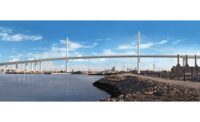When Redwood, Calif.-based CM and general contractor DPR Construction decided in 2003 to close the doors of its regional office in Portland, Ore., Jim Kilpatrick, manager with the Portland office, heard opportunity knock. Rather than relocate to another DPR office and part ways with longtime associates, including a tightly knit managerial staff, he decided he would spearhead the launch of a new firm.
In its first year, CM and general contractor Fortis Construction Inc. commenced operations with a cadre of three former DPR officers, in addition to 10 other former firm employees, four of whom Fortis appointed to leadership positions. “We picked the cream of the crop, recalls Kilpatrick, now president of Fortis. In its first year, Fortis posted revenue of $6 million, some of it from legacy work originally involving DPR.
“It was a very amicable parting,” says Fortis senior project manager Tim Sissel, one of the four employees originally tagged for a leadership role. “DPR assisted us in opening our office.” Once up and running, Fortis focused on markets it knew best, including higher education, medical and commercial tenant build-outs.
“Growth was slow but steady in those early years,” Sissel acknowledges.
“Our thought was we eventually would achieve $45 to $50 million in annual revenues and make a comfortable living,” adds Kilpatrick.
“If we hire good people, make them happy, then they will make clients happy and revenues will take care of themselves.”
– Jim Kilpatrick, President, Fortis Construction
Those early ambitions proved to be modest. Last year, Fortis saw Northwest regional revenue skyrocket to $668.6 million for 2018, or a roughly 200% increase from the $229.3 million the contractor reported for 2017.
The turning point arrived in 2007, when DPR approached Fortis about joint-venturing on a data center in Quincy, Wash., for web services enterprise Yahoo. Having withdrawn from the Northwest, “DPR didn’t have the manpower or local resources to complete the project, but we did,” says Sissel. “We also had experience with data co-location centers—earlier, less complex versions of data centers.” For its part, “DPR had the balance sheet,” he adds.
Within the world of regional data center project owners, word soon spread of Fortis’s acumen. In short order, the firm found itself either co-venturing on such projects with DPR or constructing them on its own, with its clientele including Facebook, Microsoft and Apple. The 349-employee construction firm has largely pursued data center projects on its own since 2016, Sissel says.
Kilpatrick partially credits the firm’s 2018 surge to $500 million in revenue to Facebook’s Prineville, Ore., data center campus. “We’re at the end of one phase, the middle of another phase and the start of a third phase,” he says.
Fortis also has been delving deeper into other core competencies, having recently completed work on a $44-million modernization program for the Portland State University Stott Center and Viking Pavilion, a 141,000-sq-ft student athletic facility that includes a sports medicine center. Under construction is the $30-million Tykeson Hall College and Careers Building, a facility that will house the College of Arts and Sciences and a Career Center for the University of Oregon in Eugene. Fortis also is participating in a planned $160-million student housing project on the campus.
Meantime, the firm is branching out into the K-12 educational market, says Kilpatrick, with projects including the $100-million-plus modernization of Portland Public Schools’ Madison High School, currently in the design phase.
Significantly, some 96% of its business involves repeat clients, with the company reporting exceptional growth in both its revenue and head count. Kilpatrick attributes the firm’s fortunes to culture.
“Most firms are revenue driven—working toward a given goal for a specific period,” he says. “We never think about revenues. You could say we’re like an inverted pyramid. We’re people-centric. If we hire good people, make them happy, then they will make clients happy and revenues will take care of themselves.”
It’s a strategy that has resonated with Facebook, says Matt Moews, regional data center construction manager with the firm.
“We selected Fortis to build our first data center for us in 2009, and we’ve been working with them ever since,” he says. “We have similar cultures. We’re both people-oriented, safety-oriented and driven to work hard. We construct 500,000-sq-ft data centers at a rate of one every 18 months, and Fortis always maintains pace.
“When projects encounter problems, and they all do, Fortis is always on our side of the table rather than across from us, and that’s why we keep inviting them back to the table,” Moews adds.
“We’ve had a consistent presence on Facebook’s campus for nearly 11 years,” Sissel notes.
The contractor’s collegiality with other project team members has led to longtime pairings with design professionals such as Portland-based Bora Architects.
“We’ve worked with Fortis on nine or so projects,” says Amy Donohue, a Bora principal who focuses on higher education, among other sectors. Donohue says Fortis “is a great partner and provides great insight to the preconsruction phase, whether the issue is constructibility or detail.”
Their frequent collaborations don’t occur by coincidence. “Clients like to pair firms they know work well together, as we do with Fortis, so they usually bring us on first as architect, then subsequently hire Fortis,” she explains.
Among their more challenging pairings was a cutting-edge, 135,000-sq-ft Learning Innovation Center for Oregon State University in Corvallis. The facility featured a circular lecture hall capable of seating hundreds, with the lecturer positioned in the center, similar to an arena or theater in the round.
“There had never been anything like it,” Donohue says. “We were dealing with long spans, and information projected on a screen encircling the facility below its roofline. Fortis was with us every step of the way.”
Fortis staffers exhibit other qualities that set them apart. For instance, Donohue says, “They’re fun. They bring a can-do attitude to projects.”
“It really boils down to providing our employees with freedom,” says Sissel. “They have the freedom to be entrepreneurial without being micro-managed. In fact, we have an expression: Push a button and see what happens.
“But with freedom comes assuming responsibility for an initiative,” Sissel continues. “We don’t have a lot of middle managers, and that’s intentional. We’re organizationally flat. With another contractor, I’d hold the title of chief operating officer, but with Fortis I’m a senior project manager because that’s what I do. I like to build.”
“We have no closed offices—only conference rooms,” adds Kilpatrick. “We all work side by side out in the open.”
The contractor’s culture has earned it a place on Oregon Business’ 100 Best Places to Work in Oregon for 12 consecutive years. The designation is based on employee surveys. In 2019, Fortis ranked No. 6.
A strong culture also has assisted the firm in excelling at safety, building information modeling (BIM) and sustainability initiatives. To ensure sites remain accident free, Fortis is piloting a pocket-size pre-task planning device customized for each worker. When possible the device recommends alternative, lighter-weight materials.
The firm has logged more than 1 million worker-hours without an injury. In 2017, Fortis was awarded the Oregon Governor’s Occupational Safety and Health Award, bestowed only every two years to two companies.
In the area of modeling, “We weren’t on the bleeding edge of BIM, but near the cutting-edge,” says Kilpatrick.
Fortis originally implemented the technology for clash detection. More recently the contractor deployed lasers on site to document existing conditions, then compared them to the BIM model.
In addition to recycling, sustainability initiatives involve indoor air quality, including incorporation of air exchangers to remove all volatile organic compounds prior to building occupancy.
Among other accolades, a recent project, the Portland-based LEED Platinum-rated Oregon Zoo Education Center received the American Institute of Architects Committee on the Environment award—one of 10 projects nationwide to receive the annual prize.
Fortis clearly is in a growth mode. In evaluating job candidates, “Technical ability is important,” Sissel says. “However, we also have begun placing increasing emphasis on learning about a candidate’s emotional intelligence and his or her passion for the industry. We’re looking for self-starters who can work autonomously and with a strong work ethic. If we hire the right people—those with pride and pioneering spirit—we’ll continue to grow.”







Post a comment to this article
Report Abusive Comment